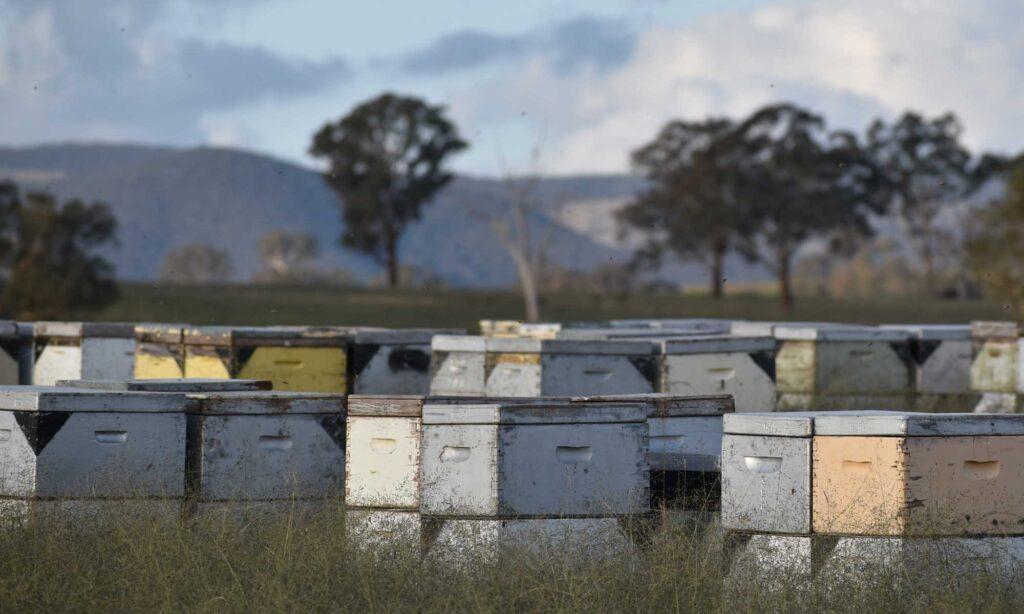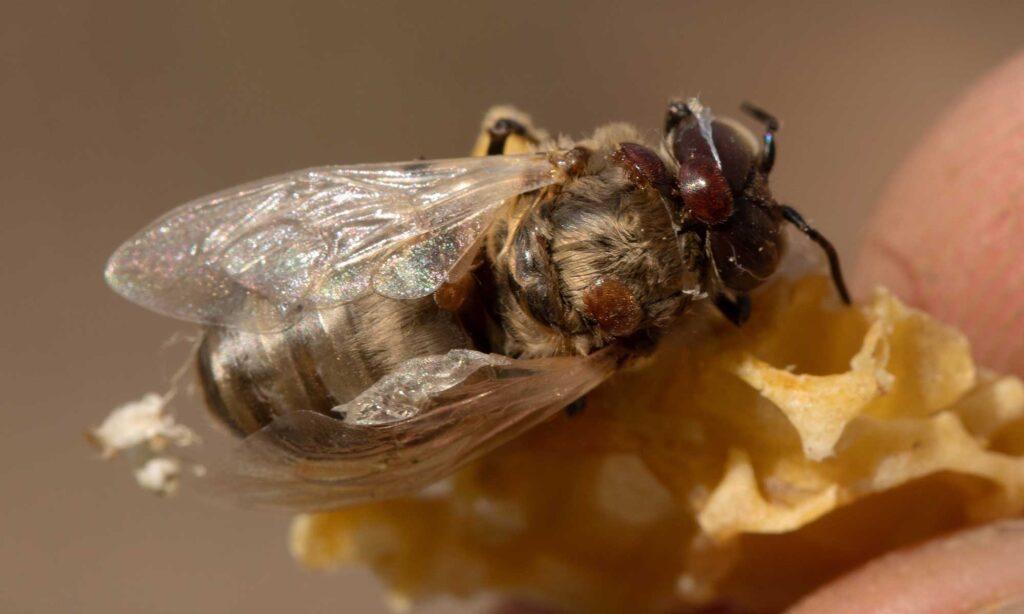Beekeepers are pushing back against the New South Wales (NSW) government’s destruction of healthy beehives in its attempt to tackle a Varroa mite outbreak, raising questions about whether total eradication of the mite is even possible. However, despite mounting calls to ‘save the bees’ with a multi-pronged management approach, the Department of Primary Industries (DPI) and industry partners maintain that a ‘zero-Varroa’ approach is the only viable strategy to avoid a biosecurity disaster.
19-year-old beekeeper James Evans became a TikTok sensation overnight when a video about the destruction of his beehives went viral. In the video, which has amassed over 1.2 million views, Evans tells viewers, “In 30 minutes, the DPI are showing up and they’re going to pour 250ml of petrol in each one of our hives, all 17 of them, we’re going to lose them all. We’ve tested them, they don’t have any. [The DPI] didn’t test it, they’re just coming here to destroy them, they don’t care.”
Subsequent videos show the aftermath of empty hives scattered on the ground, with James and his mother Andrea Evans calling for a stop to the DPI’s hive destruction.
The video highlights the ongoing debate over the DPI’s management of the Varroa mite outbreak in NSW. Until 2022, Australia had remained completely free of Varroa mite, a honeybee pest that is endemic in most other parts of the world. However, in June last year, Varroa mite was detected in Newcastle, NSW, leading the DPI to institute an emergency plan, the goal of which is ‘complete eradication’ of Varroa mite. Under the DPI’s emergency response plan, areas within a 10km radius of any hive where Varroa mite is detected are designated as ‘eradication zones’, and all bee hives within the zones are subject to destruction by the DPI.
“At the beginning we were for it,” says Andrea Evans, who owns and co-manages Vast Harvest Permaculture with James on the mid-north NSW coast. But almost a year into the emergency response, Evans says that sentiment among beekeepers is shifting. “Our concern is that the destruction has been going on for ten months, and they’re not controlling it,” says Evans. “The Varroa mite keeps getting out, so they keep having to destroy hives. There’s no way of telling how far this is moving because the wild bees are out there.”

Simon Mulvany, Founder and CEO of education and advocacy group Save the Bees, agrees that not only is DPI’s eradication strategy not working, it has now become counterproductive. “If Varroa is in more than five locations, it’s nearly impossible to eradicate – now it’s in about 150 locations,” says Mulvany, drawing a parallel between the policy tug-of-war that played out during Covid times as authorities grappled over when to make the change from lockdown and quarantine measures to management strategies geared towards ‘living with’ the virus. “I don’t think there’s a beekeeper out there that would say ‘let it fly’. They want a management strategy,” says Mulvany.
Mulvany believes that targeting stationary hives and their surrounding wild bee colonies will never achieve eradication because Varroa mite is primarily spread through migratory beekeeping. “In NSW, if they really wanted to eradicate Varroa they would stop people from moving hives completely. They’ve got a permit system happening, and so a lot of the spread is happening from people legally moving hives,” says Mulvany. “The other problem is that it’s gotten out to areas of really dense bush with so many wild bee colonies that the horse has bolted.”

58-year-old beekeeper Dolfi Benesh managed beehives in Israel, where Varroa is endemic, for 30 years before migrating to Australia. Benesh believes that the whole emergency response has been an overreaction, arguing that, “Varroa is easy to treat, easy to live with it. Every country in the world knows how to manage Varroa except Australia.” Benesh explains that bees breed much faster than Varroa, so Varroa will never outstrip the bee population. “The way to treat it is to bring more healthy bees into the area,” says Benesh. Hives can also be “cleaned” with a treatment solution, which Benesh says is used everywhere else in the world to manage Varroa infestations.
Benesh wants to see the scientific basis for the DPI’s emergency response, which he says is, “completely unscientific.” Mulvany agrees, pointing to scientific research published after Varroa mite became endemic in New Zealand, which concludes that the potential for successful eradication Australia is low.

However, Danny Le Feuvre, CEO of peak industry body the Australian Honey Bee Industry Council (AHBIC) says that ‘living with Varroa’ in Australia will not be easy. “People say, other countries are managing Varroa, so why can’t we? But Australia is a different case. Our honey production season is longer, and we have significantly higher numbers of feral bees, which host the Varroa mite and cause re-infestation of colonies,” explains Le Feuvre. “The impacts of not doing everything we can to eradicate will be significant. Where the mite is endemic in other countries, we have seen a 30% reduction in beekeepers. Over 90% of the feral bees disappear.” The DPI estimates industry losses of $70 million per year should Varroa mite establish itself in Australia.

Le Feuvre is sympathetic towards beekeepers in the eradication zones. “They’re taking the brunt of the response for the rest of Australia,” he acknowledges. NSW registered beekeepers are reimbursed for the cost of destroyed hives, and the DPI offers additional support services, but Andrea Evans says it’s not enough. It’s the ongoing consequences to the farm and the environment that Evans is most worried about.
“For the next three years, we will have no bees because what they’ll do next is use fipronil baits to poison feral bees in the area,” says Evans, explaining that without bees in the area, her farm will not be able to produce anywhere near the amount of food that it normally would. “We will not be compensated for loss of earnings. We’re a new business. Large farms can get bees ‘shipped in’ to pollinate to keep the industry going, but small farmers don’t have that much sway.”
Mulvany is also concerned about the environmental impact of the DPI’s use of fipronil to kill off domestic bees in hives and wild bees via bait stations. The pesticide, which is banned in the EU and the UK due to its toxicity, is “harmful to the ecosystem, and particularly to indigenous bees, frogs and birds that can be killed during fipronil poisoning of bees,” he warns.
Now, ten months into the DPI’s emergency response, unrest among beekeepers and advocacy groups is intensifying. The week after James Evans’s TikTok video went viral, the Evans family were shocked to receive a photo taken by an acquaintance at a DPI training session which featured a still from James’s video under the heading ‘Misinformation.’ “We ended up having a meeting with the DPI and they apologised. But we still don’t know what they meant by misinformation,” says Andrea Evans.
James Evans is calling for followers on the NSW coast to tie yellow ribbons to their letterboxes in an effort to send a message to the DPI to stop destroying hives. Benesh is crowdfunding to take the matter to the Supreme Court, where he intends to seek an injunction to stop the DPI’s destruction of hives. Mulvany wants to see limits put on artificial bee migration, and restrictions on use of harmful pesticides, including fipronil. Save the Bees offers education and grassroots action points on its website.
While AHBIC, and seemingly the DPI, are not ready to give up on the eradication strategy yet, Mulvany says that moving towards endemic management is inevitable. Paraphrasing Charles Darwin, Mulvany ends on a philosophical note. “It is not the strongest of the species that survives, nor the most intelligent that survives. It is the one that is the most adaptable to change.”
The DPI did not respond to requests for comment.



